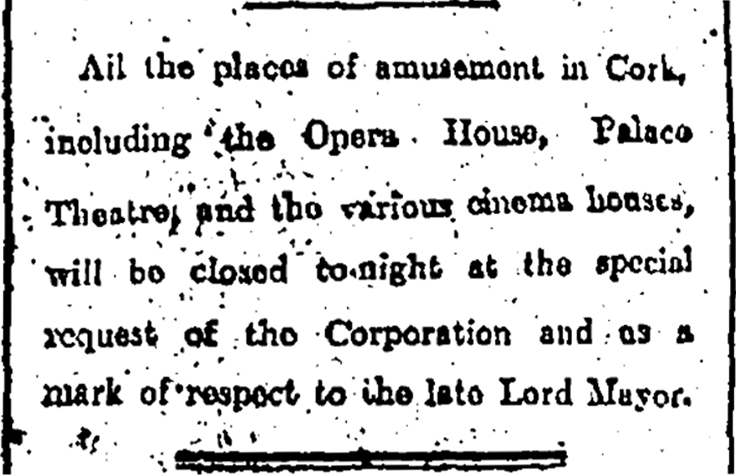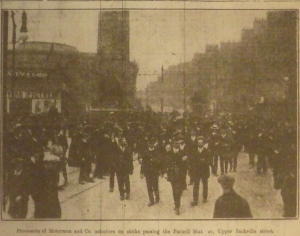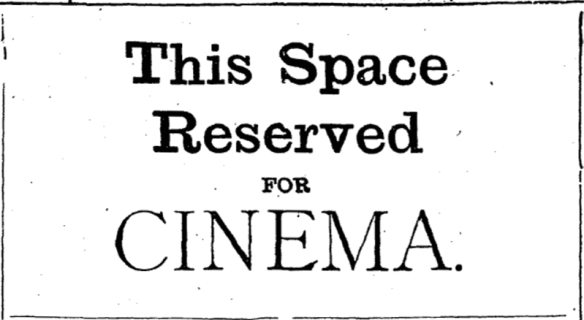
“The past year has scarcely been a bright year in the Irish film world,” the “On the Film” columnist of Dublin’s Evening Telegraph observed at the end of December 1920. “It started hopefully, got out of focus half way through, and towards the end of the picture was a ‘close-up’ in more senses than one” (“On the Film”). Although the filmic metaphor is a little opaque, the writer might have been writing about cinema a century later, albeit that in 2020 cinema went out of focus in March and has been close up in the sense that the pandemic has forced us to have most of what would previously have been cinematic experiences – going out to blockbusters, festivals or other such activities – at home, with very brief windows when the cinemas were open.
The Telegraph’s assessment of 1920 has also been reflected in this blog, which began the year hopeful by contemplating the opening of super cinemas but became less positive almost immediately not because of pandemic – although it did revisit the 1918-19 flu pandemic – but because the violence of the War of Independence was starting to affect such daily activities as cinema. While the blog spent much of the middle of the year discussing such more positive developments as the making of feature films (see here and here) and newsreels, encroaching violence became an increasing feature of the 1920 cinema year and will require more discussion here.
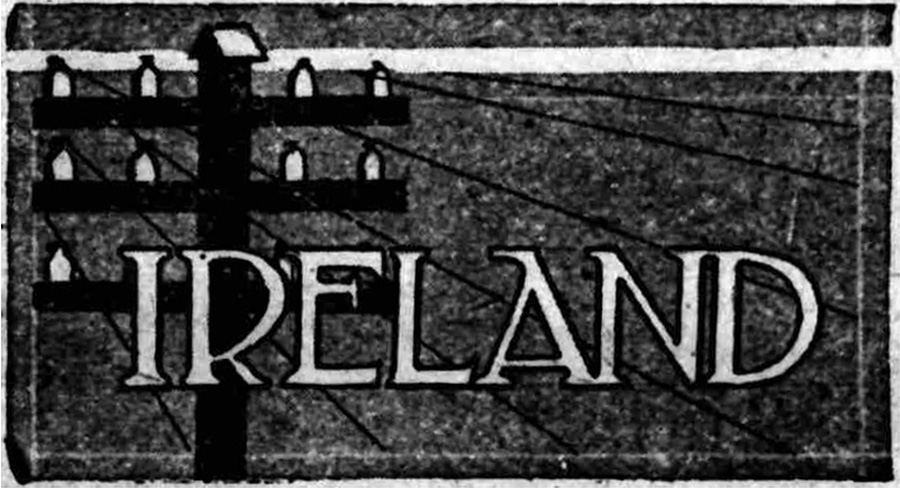
Writing a centenary blog in 2020 presented some challenges, the main one being that the blogs written after February had to rely solely on online research rather than visits to the National Library of Ireland (NLI) and other archives. This has had consequences for the range of sources used, and for the quality of obtainable images. Some freely accessible online sources for Irish cinema history exist, including films from the Irish Film Institute’s IFI player, the 1901 and 1911 Irish censuses, photographs from the NLI and maps from the Ordnance Survey of Ireland. Most other online sources require a subscription, including newspapers and trade journals, which provide the most detailed information. A selection of Irish newspapers has been digitized through two main subscription services: the Irish Newspaper Archive and the British Newspaper Archive (BNA). Both allow access to the Freeman’s Journal’s twice-weekly column “On the Film,” which fills some of the gaps left by the inaccessibility of analogue sources. Late in 2020, the BNA also released its digitization of the Kinematograph and Lantern Weekly, making its information on Irish cinema available alongside other key London-based entertainment trade journals the Bioscope and the Era. Sadly, the issues of The Irish Limelight for 1920 do not survive in digital or analogue form, and when editor Jack Warren handed this first Irish cinema journal over to contributor P.J. Flanagan at the end of 1920, it seems to have ceased publication (“Trade in Ireland”).

As a result, a combination of Irish newspapers and the trade journals provide the most comprehensive available picture of Irish cinema in late 1920. At the end of November, the “On the Film” columnist provided more apt filmic metaphors for what was happening to the trade at the time. “Last week was a black one for the Dublin picture house,” s/he wrote. “For some time past our political conditions have been throwing ominous flickers across the silver screen. Raids and ‘holds-up’ at all sorts of hours and places were already making cinegoers stick closer to the home fireside; but the new 10 o’clock Curfew is a regular ‘fade out’ for cinema business” (“On the Film,” 29 Nov.). The ominous flickers of political violence conspired with the fade-out of a curfew stricter than the midnight regulations in place since February to make the business of exhibiting films extremely difficult. The new curfew’s requirement to be indoors by 10pm meant that Dublin “cinegoers” could not attend the 9 o’clock show, usually the most lucrative of the day. “In many Cinemas the programme begins at seven, and with the big picture shown twice, the show might be described as ‘twice nightly,’” an unnamed sources at the Bohemian Picture Theatre in Phibsboro revealed, giving details of the patterns of cinemagoing and the economics of exhibition.
The second house, from 9 to 10.30 was usually the crowded one, since very few people either care or are able to go straight from work or after tea to the pictures. With the principal house knocked on the head by the order, the proceeds of the first performance would never be sufficient to make picture pay. (“May Have to Close!”)
In mid-December, the Bioscope’s Ireland correspondent JAP reported on the possibility of preventing the fade out caused by the curfew, observing that “the latest rumour is that there may be a couple of extra hours of freedom for the citizens of Dublin during Christmas week, but it is only a rumour” (“Irish Exhibitors to Carry On”).So it proved. “Picture houses and other places of amusement which look to this week rather than to last week for their best patronage round about the Christmas season,” the Freeman reported on 28 December, “can scarcely now expect, since the authorities refused to listen to the plea for a Christmas week relaxation to be more fortunate in this respect than the traders” (“Effect of Arson”).
To address their loss of income, cinema proprietors negotiated with their employees when their representative organization the Dublin and South of Ireland Cinematograph Exhibitors Association entered talks with the Musician Union and Irish Transport and General Workers Union (ITGWU). The musicians – “and they include many men of considerable note in their profession” – agreed to a 21-hour week and to give two free matinees a week (“Irish Exhibitors to Carry On”). After the ITGWU negotiation, JAP reported that the other “employees have agreed to accept 15 per cent. less as long as the present Curfew hours obtain in Dublin” (“Trade in Ireland”). “Did anybody say anything about ‘A Merry Christmas?’” JAP asked rhetorically.

La Scala was the one Dublin cinema that JAP reported would continue to pay full wages. We have said something here in January about its size and the fact that it was the first cinema in central Dublin to have inveigled Sunday opening. This favourable position vis-à-vis Dublin’s other cinemas may be part of the reason its management decided to treat its staff differently, but a return to say something about its opening reveals that it may not have been attributable to the management’s generosity. When proprietors Frank Chambers and George Fleming chose the week beginning 9 August 1920 for the opening, few people would have been surprise that they timed it to coincide with Horse Show week, the city’s busiest entertainment week of the year during the Royal Dublin Society’s longstanding horse show at its show grounds in Ballsbridge. But things didn’t go quite to plan as opening day approached. A split in the electricians between those affiliated with the London-based Electrical Workers’ Union and the ITGWU on what union the projectionists should belong to looked like it would leave the cinema unable to open because of a strike. Last minute negotiations meant that while La Scala did open during Horse Show week, it was not on the Monday as planned but on Tuesday, 10 August. In the process, the unions had sent a message to the management about the power of organized labour that seems to have been heeded months later.
Union activity was at the forefront of the War of Independence in ways that would have consequences for cinemas. Members of the rail unions refused to work on trains carrying soldiers, police or their munitions, thereby disrupting military and police deployment. An unintended but inevitable consequence was that all transport was disrupted, including the distribution of films. This dispute would not be resolved until the end of December 1920, and JAP commented on the serious plight for Irish film renters or distribution companies. “The number of towns to which it is possible to send films for screening grows steadily less,” he noted in mid-December. “When one sends out a film to the Irish country districts nowadays it is with a feeling of relief, not altogether unmixed with surprise, that one finds it returned in due course” (“Trade in Ireland”).

JAP also noted one particularly surprising return. The Dublin office of distributors Western Import had written off the copy of the Western Keith of the Border (US: Triangle, 1918) that was showing at Cork’s Lee Cinema on the night of 11-12 December. That night, British forces burned large part of the centre of Cork, and the Lee Cinema at 1-2 Winthrop Street was one of the premises destroyed. “The carrying case had evidently been through the flames, and the tins inside were rusted from contact with water,” JAP revealed, “but the film itself was undamaged. / Moral:—Exhibitors should see to it that films are packed and returned to their cases each night immediately after having been shown, and thus lessen the chances of damage by fire.”

The destruction of the Lee just weeks after it opened at the start of November might be symbolic of Irish cinema’s fade out in 1920, but many more cinemas opened in 1920 than were closed either in this dramatic fashion or for more mundane commercial reasons. Cork began the year with the opening of Washington Street Cinema on 15 January but was particularly well served with suburban cinema openings in autumn 1920, with both the Blackpool on the Watercourse Road and Bellvue on Military Road opening on the same day, 25 October, a week before the Lee. The lavish Pavilion on Patrick Street was still under construction at the end of the year and would open in March 1921. In Sligo, the Boyne Cinema Company may have claimed the first opening of the year, when it offered film shows in the Assembly Room of the Town Hall. The Kilgannon family, who ran the Sligo Picture Theatre on Thomas Street closed the year by launching the Pavilion just metres away in the same street on Christmas day. Early summer saw several opening in Dublin: 10 May saw the opening of both the Manor Cinema on Manor Street and the Lyceum Picture Theatre at the renovated Volta premises at 45 Mary Street; on 13 May, the Palace Cinema opened in the remodelled Antient Concert Rooms on Brunswick Street. Autumn in Dublin saw the Theatre de Luxe open on Camden Street on 4 September and the AOH Hall at 31 Parnell Square begin screening on 4 October. Elsewhere, Limerick’s Garryowen opened on 5 March on Broad Street; the Abbeyfeale Cinema opened in mid-May; Wicklow’s Excelsior became that town’s first cinema on 14 December; and ironmonger Michael Connolly opened a cinema at his premises in Ballymahon, Co. Longford over the Christmas season.

These openings pointed in a much more promising direction than the destruction of the Lee during the burning of Cork, and cinema would not, of course, fade out completely at the end of 1920. However, the marked intensification of the War of Independence in the summer of 1920 did impact it severely. The Restoration of Order in Ireland Act came into force on 9 August, giving the military sweeping new powers of arrest and trial. The Royal Irish Constabulary (RIC), already strengthened by recruits from Britain, many of them unemployed former soldiers dressed in a distinctive black-and-tan uniform, was further bolstered by an Auxiliary Division of former British Army officers. The burning of Cork was a reprisal by the Black and Tans, Auxies and British soldiers after the Auxies had suffered heavy casualties at the hands of the IRA during the Kilmichael ambush on 28 November. Cork was the worst single act of burning buildings as an act of reprisal, but it was a widespread tactic, with cinemas only occasionally being targeted. A cinema in Tullamore was bombed and burned as a reprisal for the killing of RIC sergeant Henry Cronin on 30 October (“Reprisals for Tullamore Murder”). However, the reprisals in Tullamore and many other towns were relatively minor in comparison to Cork and such other extensive incendiary attacks as the sack of Balbriggan on 20 September and the destruction of Tuam on 21 July.
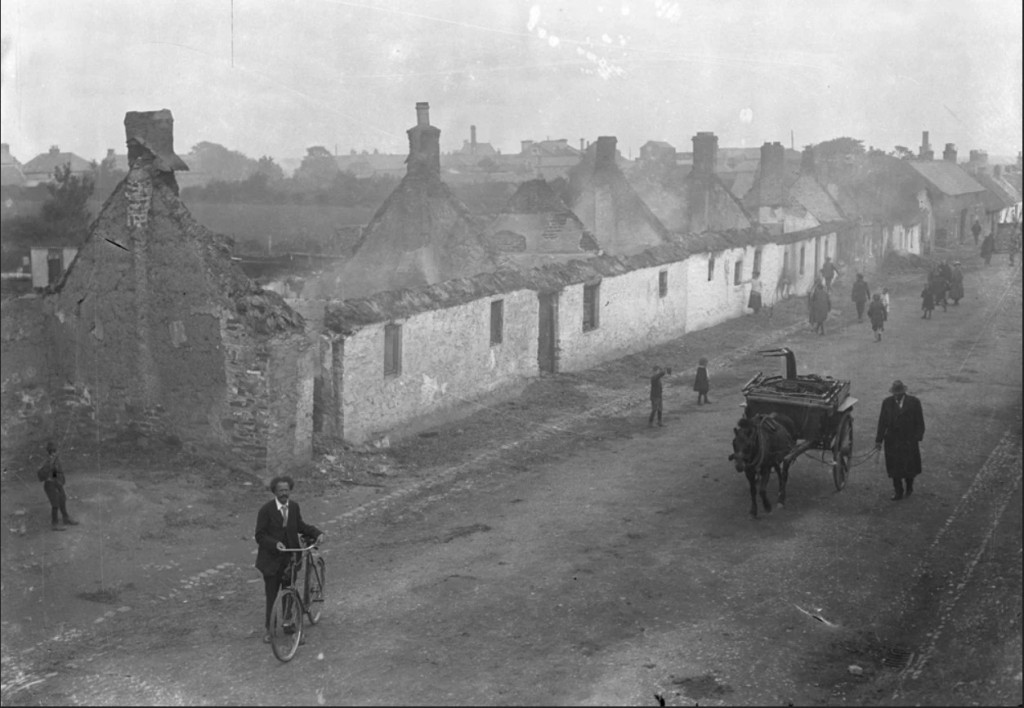
Films of the aftermath of the burning of Balbriggan and Tuam provided evidence of the continuing importance of Irish filmmaking in offering a perspective that could challenge British propaganda. An Irish Events newsreel of Tuam was shown in several cinemas on the week of 5 August. “A just conception of the military occupation of Ireland,” the Waterford News and Star remarked, “was afforded last night in the Broad Street Cinema by a series of pictures showing the ruins of Tuam from enemy incendiarism. The fine Town Hall building is a mere skeleton and affords eloquent evidence of British vandalism” (“Burning of Tuam”). The Town Hall had also been the venue for film entertainments over two decades. The Irish Events film of Balbriggan seem to have an even greater impact. It was shown in Irish cinemas in the week of 27 September, a week after the destruction of the town, with several newspaper carrying the comment that “Irish film companies were in a position to show thousands the sack of Balbriggan, and men, women and children running from their burning homes as the peasantry fled from the onrush of the Germans in Belgium and France” (“Seen Through”). It was also shown in America, where, the Freeman’s Journal suggested in November, cinema was contributing to the struggle for Irish independence by exposing US audiences to such Black-and-Tan atrocities as the sacking of Balbriggan “in the cinemas all over the country, the correspondent himself having seen them nearly two thousand miles from the coast” (“Cinemas Tell the Tale”).

A cameraman from Irish Events was also quickly on the scene on Dublin’s Talbot Street on 14 October following a shoot-out between of IRA activist Seán Treacy and British soldiers and secret service agents that left Treacy and two of the secret service agents dead. The film survives and can be viewed on the IFI Player, including the scene that Evening Herald “Flickers from Filmland” columnist drew particularly attention to, of “the crowd running from the menace of further shooting, and the still group of victims on the footway, [which] makes a most unusual contribution to film history” (“Flickers from Filmland”).

The most notorious 1920 attempt by the British authorities to use the visual media of photography and film to sway British public opinion against the Irish Republican cause came in the guise of the co-called Battle of Tralee (see Barry, Grant). This was actually an IRA-Black-and-Tan skirmish on 12 November at Ballydwyer creamery in Ballymacelligott, on the road between Tralee and Castleisland, that had left two men dead. By chance, Dublin Castle’s police information officer Captain Hugh Pollard was leading a party of foreign correspondents in the area, and they happened across the aftermath of the incident. Among them was journalist Clifford Hutchinson, who reported in the Yorkshire Post on 15 November that “two cinema operators accompanying the party set up their apparatus, and despite the bullets flying around, […] coolly took photography of the fight (“Stern Struggle with Sinn Fein”).
Subsequent events suggest that these cinematographers were working for British Pathé, but Pollard saw an opportunity to create a more politically useful event. Staged photographs of the incident appeared in several British publications, including the Illustrated London News, but were quickly exposed as fakes taken at Vico Road in Killiney, Co Dublin. Film was also supposedly shot at Vico Road and incorporated into a newsreel item released by Pathé on 18 November 1920. “The film, which was taken under fire,” the Daily News reported and the Freeman’s Journal reproduced, “shows wounded Sinn Feiners being led away as prisoners by Auxiliaries of the R.I.C., and struggling vigorously, in spite of their condition. An Irish girl is show pleading with the British troops to allow her brother to go free. In the end he is led away in a lorry” (“A ‘Fight’ Near Tralee”). ”). Although this film seems to have been released, it does not seem to survive in the British Pathé archive, and this may be because it was exposed as a fake. Confronting the British Attorney-General in the House of Commons about the faked photographs in early December, Irish Parliamentary Party MP Jeremiah MacVeagh asked “whether a film was also taken and had to be abandoned because at the ‘private view’ it was found that one of the corpses had moved? (Laughter)” (“Grim Reality”).
Violence by crown forces was the most prevalent, destructive and disruptive of cinemagoing, but Republicans also sought to control cinema and even attacked cinemas and cinemagoers. The Irish Independent reported that on 12 June 1920, what it called the “Republican secret service” arrested fifteen boys aged between 14 and 18 for committing robberies in Cork, and the Sinn Fein court’s prosecutor recommended that the Corporation take measures “to prevent children attending pictures, except on specified nights, when pictures tending to educate and to elevate the minds of the boys would be shown” (“Irish Volunteers’ Activity”). On 14 August, Cork papers reported that in the absence of the recently arrested Lord Mayor Terence MacSwiney, the Corporation had passed a resolution calling on the Irish Republican Government to introduce film censorship (“Cork Town Council”). When cinemas closed on 29 October as a mark of respect and protest at MacSwiney death on hunger strike in Brixton Prison, some closures were enforced by the local Voluneers/IRA. The Irish Independent reported that the Dungannon picture house had closed at the request of the Volunteers, who had also stopped several dances (“Dances Stopped”). “A school teacher returning to his home in the village of Crossgar, Downpatrick,” the Irish Times revealed in relation to the same event, “was seized by a number of men who cut off his hair because he attended a performance at the local picture cinema theatre which Sinn Feiners desired to have closed owning to the death of the Lord Mayor of Cork” (“Incidents in the Provinces”).
Ominous flickers certainly played across Ireland’s silver screens as 1920 faded into 1921.
References
“The Adapting of Programmes to Curfew Times.” Freeman’s Journal 29 Nov. 1920: 8.
Barry, Michael B. “How the British Faked ‘Battles’ During the War of Independence.” Irish Times 20 Jun. 2019. https://www.irishtimes.com/culture/books/how-the-british-faked-battles-during-the-war-of-independence-1.3930891
“The Burning of Tuam: Picture Shown in Waterford.” Waterford News and Star 6 Aug. 1920: 7.
“Cinemas Tell the Tale.” Freeman’s Journal 11 Nov. 1920: 6.
“Cork Town Council.” Evening Echo 14 August 1920: 2.
“Dances Stopped.” Irish Independent 29 Oct 1920: 6.
“Effect of Arson Upon Wholesale Trade.” Freeman’s Journal 28 Dec. 1920: 3.
“Flickers from Filmland.” Evening Herald 23 Oct. 1920: 2.
Grant, David. “The Battle of Trallee Fought at Vico Rd, Dalkey” The Auxiliary Division of the Royal Irish Constabulary. http://theauxiliaries.com/INCIDENTS/vico-road/battle-vico-road.html
“Grim Reality.” Irish Times 3 Dec. 1920: 6.
“Incidents in the Provinces.” Irish Times 3 Nov. 1920: 5.
“Irish Exhibitors to Carry On: Negotiations with Staffs to Cope with Diminished Earnings.” Bioscope 16 Dec. 1920: 5.
“Irish Volunteers’ Activity: Seizures of Still and Poteen.” Irish Independent 12 Jun. 1920: 7.
“May Have to Close! Variety Theatres Hard Hit by Curfew Time: Cinemas Suffer Too.” Freeman’s Journal 29 Nov. 1920: 6.
“Military Activity: Raids and Arrests in Dungarvan.” Waterford News and Star 6 Aug. 1920: 2.
“‘No Control of the Men’: Conduct of Police in Limerick.” Nenagh Guardian 31 Jul. 1920: 4.
“On the Film.” Freeman’s Journal/Evening Telegraph 29 Nov. 1920: 8; 16 Dec. 1920: 6; 30 Dec. 1920: 2.
“Reprisals for Tullamore Murder: Jury Condemns the Crime.” Belfast News-Letter 2 Nov. 1920: 5.
“Seen Through.” Ulster Herald 9 Oct. 1920: 5.
“Stern Struggle with Sinn Fein: The Tralee Ambush.” Yorkshire Post 15 Nov. 1920: 7.
“The Trade in Ireland: Irish Cinema Staffs Accept Reduced Wages for the Duration of the Present Curfew.” Bioscope 30 Dec. 1920: 25.

